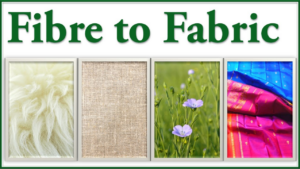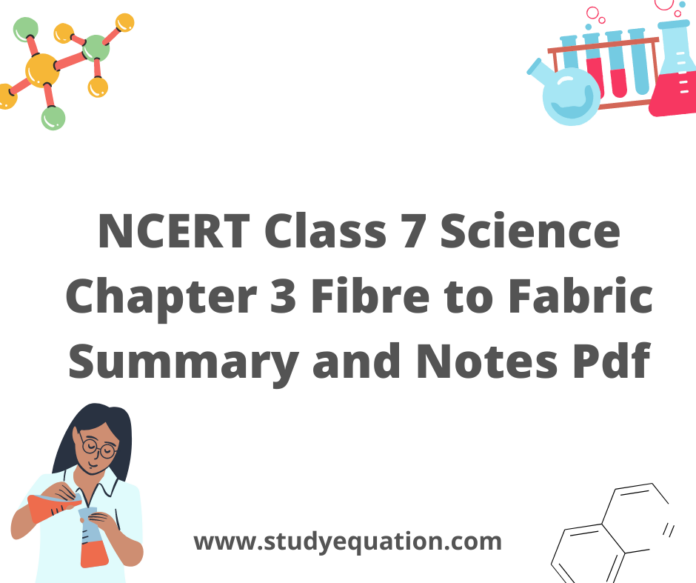The free download of NCERT Class 7 Science Chapter 3 Fibre to Fabric Notes for Quick Revision by CBSE is available. You can get the NCERT Science Notes for the Class 7 chapter on “Fibre to Fabric.”
The third chapter of the science curriculum for Class 7 is focused on Fibre and fabric. This chapter thoroughly explains how different Fibres are used to create textiles. This chapter also discusses the methods used to get different plant and animal Fibres. These revision notes for all the subjects and subtopics addressed in this chapter have been written by our subject specialists in a clear, point-by-point way.

Table of Contents
NCERT Class 7 Science Chapter 3 Fibre to Fabric Introduction
We all have clothing on. They are our fundamental necessities. Humans have covered their bodies with leaves, tree bark, and animal skins for a long time. After mastering the craft of weaving, they began producing fabric.
Fabrics (or clothes) are produced from incredibly tiny Fibres and threadlike strands. Cotton, wool, silk, flax, jute, nylon, polyester, and polyacrylic are a few examples of Fibre . Next, the Fibres are spun into yarn, a long continuous thread that may be used to weave fabric on a loom (or cloth). A form of lengthy, twisted thread is a yam. Spinning is the method used to turn Fibres into yarn.
There are two kinds of Fibres: natural and synthetic Fibre (nylon, rayon). In addition, some of the yarn used to make our garments are manufactured from the animal Fibre. These are the many categories of natural fibres as they are found in nature. Natural fibres are fibres that come from living things like plants and animals.
NCERT Class 7 Science Chapter 3 Fibre to Fabric Summary
Plant-based fibres
The significant components of plant fibre are cellulose and cellulose fibres. Paper and fabric are the most typical products made from them.
When properly processed, cellulose produces long, frequently extremely glossy fibres.
Plant fibres are produced from various plants, such as cotton, jute, flax, and hemp.
Visit this page to learn more about plant fibres.
Jute
Jute fibre can only be extracted from the stem of jute plants. It has a silky feel, is long and lustrous, and is grown during the wet season. Jute is mainly grown on alluvial soil, which is present in the Ganges and Brahmaputra river delta regions.
Fibres
Fibre describes the thread’s more delicate strands. A structure like a thread called fibre is spun into ropes, textiles, and strings. The fibres used to create fabrics can be found in natural and synthetic sources. Examples include rayon, nylon, and polyester.
Fibre, Yarn, and Fabric
Thin strands called yarn and even more delicate strands known as fibres make up the fabric.
Cotton Processing and Cotton
Cotton is made from cotton bolls, which grow on the cotton seed’s surface. It grows in a warm environment with black clayey soil. Cotton is processed by ginning, spinning, weaving, and knitting.
Fibre from Animals
Wool
natural animal fibre derived from animals like sheep, goats, yaks, camels, etc.
All these creatures have a hairy coat removed to produce wool fibres.
Processing fibres into wool
The sheep’s fleece comprises two fibres that make up its hairy skin: I, the coarse beard hair, and (ii) the fine, soft under hair located close to the skin. The central supply of wool fibres comes from this fleece. Shearing, scouring, sorting, dyeing, straightening, rolling, and combing are all steps in turning fibre into wool.
Silk
Animal-Produced Silk
Silk is a naturally occurring protein fibre that may be used in textiles and is derived from silkworms.
Different kinds of silkworms create many sorts of silk.
It may be distinguished based on texture and shine. Kosa, Tassar, Mooga, etc., are a few instances. Different varieties of silk moths make them. The mulberry silk moth is one of the popular varieties.
sericulture
Sericulture is the technique of raising silkworms to create raw silk.
Silkworms are raised throughout this procedure at the proper temperature and humidity to extract silk threads from cocoons.
Processing Cocoon-Obtained Silk
To extract the silk fibres, cocoons are gathered, left outside in the sun, or cooked.
After the process of reeling silk from a cocoon is complete, silk is unwound.
After that, the silk fibres are spun into threads.
The intended clothing is made using the acquired silk strands.
Natural versus artificial fibres
Natural Fibres
Natural Fibres Natural fibres are derived naturally from plants or animals.
Zoological fibres: These are the fibres that come from animal sources. Wool, silk, as examples, etc.
Fibres derived from plants are referred to as plant fibres. To create textiles, these fibres are taken from the plants.
Fibres
Artificial fibres are fibres that are created by humans using chemicals.
These outlast natural fibres in terms of durability.
For instance: acrylic, nylon, and polyester.
NCERT Class 7 Science Chapter 3 Fibre to Fabric Notes
The Making of Wool
Wool is mainly derived from sheep, yaks, and goats. These animals’ fleece or hair is used to produce wool.
Wool production from sheep
Sheep’s hair has two different types of fibres:
1. Rough hair on the beard
2. The sheep’s silky under hair that is found very next to its skin
Because of its exquisite quality, sheep’s silky hair is used to make wool.
Selective breeding:
Sheep may undergo selection to produce a breed with little to no hard hair and only fine, silky hair on the skin. Selective breeding is the name of this procedure.
Grass typical leaves, call, pulses, oil cakes, and dry fodder are typically fed to sheep.
To obtain wool from them, sheep are grown (bred and raised) throughout India, including in Jammu & Kashmir, Rajasthan, Arunachal Pradesh, and Gujarat.
The method for producing wool from animal hair fibre
1st step: shearing
It is a procedure when the sheep’s fleece and a small layer of its skin are removed. Shearing often occurs in warm weather, so the sheep do not experience cold and have an easier time surviving. In addition, since the upper portion of the skin is usually dead skin, the shearing procedure does not harm the sheep.
2nd step: Scouring
It is a procedure to clean the hair pulled from the sheep of dirt, oil, and dust. Machines are usually used to assist with this.
3rd step: Sorting
It is the process of sorting sheep’s hair into different textures.
4th step: Burr removal
The burrs or tiny fibres on the hair are removed in this stage. The hair is then cleansed and dried. The resultant product is wool that can now be turned into fibres.
5th step: Dyeing the fibres of wool
The fibres are given different color dyes in this process.
6th step: Rolling the wool
The wool fibres are then straightened up, combed, and rolled into yarn as the last stage.
Occupational Risk
Workers in several sectors run the danger of contracting illnesses and occasionally even passing away. These are referred to as occupational risks. For example, an occupational hazard connected to the manufacture of wool is sorter’s sickness. The Anthrax bacterium can infect the individuals who sort the wool. This bacteria affects the victim’s blood, which might result in tragic demise.
Silk Production
1. Silkworms produce silk. Sericulture is the cultivation and care of silkworms to harvest their silk.”Silk Moth”
2. Caterpillars or silkworms are the larvae formed after the silk moth’s eggs hatch.
3. The pupa is the following caterpillar’s life cycle stage.
4. The caterpillar builds a net that can hold it to progress to this stage.
5. Following that, the caterpillar swings its head in an eight pattern.
6. Fibre is secreted when it swings its head.
7. When this protein-based fibre is exposed to air, it hardens and transforms into silk fibre.
8. After that, the caterpillar wraps itself in silk and transforms into a pupa.
9. The term “cocoon” refers to the caterpillar’s covering.
10. Then, the caterpillar transforms into a silk moth within this covering.
11. The cocoon is where the Silk thread on the Silk yarn is taken from.
12. Due to the vast varieties of silk moths, several types of silk may be produced.
The method for harvesting silk from silkworms
1. Rearing: The silkworm farmers purchase and rear the silkmoth eggs.
2. Because a single silk moth may lay roughly 100 eggs at a time, these eggs are often abundant.
3. These eggs are kept in a setting with the proper humidity, temperature, and hygiene standards.
4. The larvae are heated to help them emerge from the eggs.
5. Then, a bamboo tray is used to keep them.
6. To ensure that the caterpillar has adequate food, this operation is often carried out when the new leaves on the mulberry trees emerge.
7. After around 25 to 30 days of feeding, the caterpillar travels into a chamber in the tray to begin building a cocoon.
8. When spun, the cocoon adheres to the train’s rocks in Bangalore.
Silk processing
First, after being purchased, the cocoons are either maintained in the sun or cooked to allow the silk fibres to separate from them.
Following that, the silk is reeled. It is a procedure used to prepare the cocoon’s strands for usage as silk.
The resulting acquired silk fibres are then pulled and coiled into threads.
NCERT Class 7 Science Chapter 3 Fibre to Fabric Pfd Download
NCERT Class 7 Science Chapter 3 Fibre to Fabric Conclusion
Fabrics and cloth are produced from fragile fibres and threadlike strands. Cotton, wool, silk, flax, jute, nylon, polyester, and polyacrylic are a few examples of fibres. The fibres are spun into yarn, and the yarn is then used to weave fabric or cloth on a loom.
NCERT Class 7 Science Chapter 3 Fibre to Fabric FAQs
Q1. What functions does jute serve?
Answer. 1. Paper and pulp
2. Domestic goods
3. Geotextiles
4. Recently replacing plastic coverings
Q2. Describe yarn.
Answer. A lengthy continuous length of interlocking fibres, or yarn, is used in sewing, crocheting, and other crafts.
Q3. The natural fibre is what?
Answer. Plant, animal, or mineral fibres are known as natural fibres.





